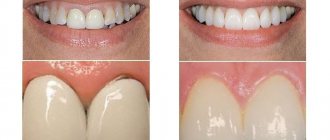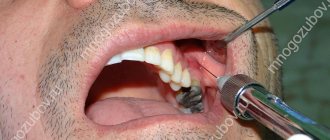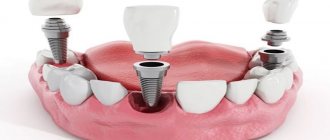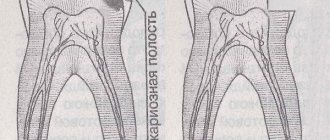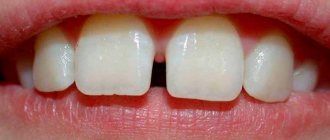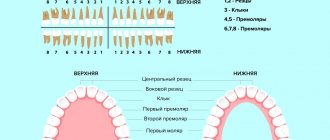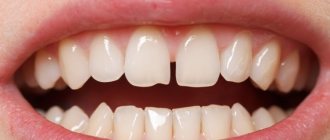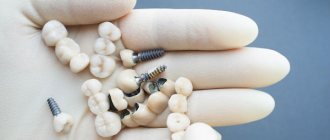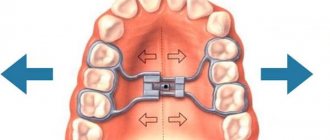18.05.2018
6106
Sign up for a free consultation:
- 1 Why are crowns needed?
- 2 Why does the crown interfere with the bite?
- 3 What to do if a temporary crown comes off?
- 4 Do I need to see a dentist?
One of the most common services provided by orthopedic dentists is the production of dental crowns. Crowns are permanent dental prostheses that can be single or fastened together. People who have undergone prosthetics often complain that the crown of the tooth interferes with chewing. Let's look at the causes and possible solutions to this problem.
Causes
When fixing the crown, a small indentation is left between its base and the gum tissue. This is done to ensure ease of use and quality of hygiene of artificial teeth.
When the prosthesis fits correctly, the size of the gap is no more than 1 mm, however, there are situations when the rinsing space expands, causing discomfort and pain.
Factors that directly affect the human oral cavity, so-called local causes, can provoke an increase in the gap between the crown and the gum.
The main ones are:
- an error by the orthopedist when fixing the crown - the specialist could not have fastened the artificial tooth tightly enough to the base or, conversely, pressed it too hard;
- improper manufacturing of the orthopedic structure - discrepancy in size or shape;
- poor oral hygiene , resulting in the accumulation of bacterial plaque, leading to the development of inflammatory processes in the gum tissue;
- the occurrence of an allergic reaction to the materials from which the crown is made;
- poor-quality measures to sanitize the elements on which the prosthesis is fixed. This can lead to the destruction of stump tissue and the development of an inflammatory process in the periodontium;
- the occurrence of galvanic syndrome due to intolerance to prostheses made of metals;
- regular mechanical trauma to the gums as a result of performing hygienic procedures with a brush with hard bristles or installing an excessively high filling;
- change in the position of teeth adjacent to the prosthesis as a result of the development of periodontal disease or periodontitis.
There are also a number of common reasons that can cause an increase in flush space:
- diseases of the endocrine system, in particular diabetes;
- hormonal changes in the body caused by pregnancy, menopause;
- development of immunodeficiency states.
What does the smell from under the crown indicate, and how to get rid of it.
Visit here to learn about the indications for using half-crowns.
At this address https://www.vash-dentist.ru/protezirovanie/nesemnyie-p/koronki-np/pochemu-na-implante-shataetsya.html we will explain why the crown on the implant is loose.
Reasons why a patient is bothered by a crown
Very often, the patient’s complaint that he constantly feels the crown in the oral cavity is in the way is due to the illiterate work of the orthopedic doctor or technician. The main reasons for defects on the part of the dental laboratory are the production of a structure slightly larger than required, insufficient polishing of the ceramics or ceramic coating.
At the stage of clinical work with the patient and the microprosthesis, the orthopedic surgeon may use a larger amount of cement to fix the structure than is necessary, which will manifest itself in a slight overestimation of the height of the artificial tooth. Incorrect positioning of the prosthesis (rotation, deep immersion under the marginal gum) can lead to a subjective feeling of interference. This leads to pressure on adjacent teeth or on the marginal periodontium, which is felt as discomfort and even pain.
If a crown made of plastic interferes as a permanent or temporary structure, it is quite possible that under the influence of oral fluid the polymer material has swollen and puts pressure on the surrounding tissue.
But sometimes a feeling of interference, discomfort or severe pain is associated with damage to the tooth stump. If an abutment tooth develops acute periodontitis or an exacerbation of a chronic process, exudate accumulates in the periodontal gap, which microscopically increases the height of the tooth, but subjectively there is a feeling that it has “grown.” Sometimes inflammation of the adjacent gum occurs, and the patient may interpret his feelings as interference from the recently installed microprosthesis.
First signs
An increase in the gap between the artificial tooth and the gum tissue may be accompanied by the following sensations in a person:
- itching in the area of the pathological process;
- pressure of an artificial tooth on the gum;
- insufficiently tight fit of the prosthesis, its protrusion from the general row;
- increased rate of tartar formation.
The pathological process is often accompanied by a change in the color of the soft tissue of the oral cavity - acquiring a reddish or bluish tint. In some cases, the gums may swell, bleed, and fester.
If the widening of the gap is associated with improper fixation of the crown, the patient may experience the following complaints:
- difficulties in pronouncing certain sounds that are not related to the functioning of the language;
- the formation of whistling sounds during a conversation due to the penetration of air into the cracks formed due to incorrect installation of an artificial tooth.
Algorithm for installing a dental crown
- The problematic tooth is prepared. Preparation is the removal of a layer of hard tissue from a tooth - enamel and dentin - using a special bur. The tissues are not removed in any order, but to give the stump a special shape - one on which the prosthesis will hold well. For example, if the stump is too pointed, the fixation on it will be weak.
- Taking impressions for dental technicians. Impressions are taken from the ground tooth, from neighboring teeth, and from antagonists.
- Making a prosthesis in accordance with the information obtained from the casts.
- Crown installation.
It is obvious that each of the stages directly affects the quality of the future prosthesis, which means it must be performed by a highly qualified and experienced specialist. If you do not take into account the iatrogenic factor, then the formation of a gap may be a consequence of:
- Diseases of the tooth under the crown. So, if caries develops in it, it quickly destroys the tissue, the crown will no longer fit tightly to the stump and a gap will arise.
- Cementation of the crown. If the cement has deteriorated due to the long life of the prosthesis or for other reasons, it gradually falls out, voids form and a gap appears.
- Crown destruction. Under constant mechanical stress, the crown may become damaged. If a small piece breaks off from it, the patient will feel the presence of a gap in this place.
- The gums have receded, and a noticeable gap has formed between the base of the crown and the mucous membrane. Pathological processes with gum tissue can be caused by inflammatory or dystrophic processes (periodontitis).
In any case, you need to see an orthopedist as soon as possible, because whatever the reason was, the defect needs to be eliminated as soon as possible. If we are talking about a tooth disease under the crown, it can worsen, go down to the root or even the jawbone, causing serious pathologies that are fraught not only with tooth loss, but also with danger for the entire body. If the gap has formed due to the destruction of cement, then in the near future the crown will fall off, most likely break, and will require significant expenses for re-prosthetics.
Separately, it is worth mentioning the gap that orthopedists leave between the gum and the crown on purpose. It is called the flushing gap. The fact is that an absolutely tight fit of the prosthesis to the gum mucosa is undesirable and dangerous. The hard material will rub and injure the gums, squeezing the vessels and leading to tissue necrosis. The size of the flushing gap for high-quality prosthetics should not exceed 2 mm. The flushing gap must be thoroughly cleaned after eating to prevent the accumulation of food residues.
Author:
Mayorov Andrey Mikhailovich
Specialization:
orthopedic dentistry, dental prosthetics, implant installation
Possible complications
Increasing the flushing space can lead to a number of negative consequences. First of all, this is the emergence of difficulties in the process of eating, associated with the penetration of food particles and bacterial plaque into the resulting gap.
The situation over time leads to the development of serious dental diseases, such as:
- Gingivitis is an inflammation of the gum tissue that does not affect the teeth and periodontium.
The disease is characterized by swelling, bleeding of the gums, and changes in their color. In the absence of timely treatment, gingivitis is fraught with ulceration of the gum tissue, the formation of abscesses on it, and the penetration of infection into the periodontium. - Stomatitis is an inflammatory process that occurs on the oral mucosa, accompanied by pain, swelling of soft tissues, and the formation of ulcers.
As a rule, eliminating the pathology does not cause difficulties, however, there are cases of secondary infection. - Periodontitis is an inflammatory disease that affects the tissues surrounding the tooth.
As a result of inflammation of the ligamentous apparatus, there is a risk of developing pathological mobility of the elements of the row, which, if left untreated, can lead to their loss.
Elimination tactics
When a patient complains of an increase in the gap between the artificial tooth and the gum, the dentist conducts a thorough examination of the prosthetic area. X-rays may be required to clarify the diagnosis.
The treatment plan depends on the degree of complexity of the pathology. If there is slight deviation of the gums from the crown, therapy consists of performing the following procedures:
- Removal of mineralized plaque. Using ultrasound or a special device, the specialist cleans the tooth surface from bacterial plaque, after which he performs closed curettage of the periodontal canals.
The procedure allows you to remove subgingival stone using dental instruments without resorting to cutting the gums. - Carrying out anti-inflammatory and antibacterial therapy. The treated areas of soft tissue are treated with special preparations, such as Chlorhexidine, Miramistin.
In the case of an acute inflammatory process, broad-spectrum antibiotics are prescribed.
In advanced cases of expansion of the lavage space, therapeutic methods of treatment are ineffective. To eliminate the pathology, surgical intervention is required.
There are two options for performing the operation:
- Open curettage. The procedure is performed by opening the periodontal pocket to a depth of 4-5 mm.
A specialist removes a flap of gum in the affected area, followed by deep tissue cleaning using special devices. After treatment with an antiseptic drug, the flap is fixed in its original place using suture material. - Flap surgery. The operation involves separating a flap of gum using several incisions, cleaning open areas of pathological material and treating with antiseptic agents.
After this, the previously detached gum flap is applied and fixed using surgical sutures.
The postoperative period requires the patient to be careful when caring for the elements of the oral cavity. To avoid opening of periodontal canals, you should refrain from brushing your teeth and using mouthwashes for 10 hours after surgery.
In the future, it is advisable to use a brush with soft bristles and avoid contact with the operated area.
Causes of allergies to dental crowns and how to get rid of them.
In this publication we will look at the features of Shofu metal ceramics.
Here https://www.vash-dentist.ru/protezirovanie/nesemnyie-p/cad-cam-sistemyi-v-stomatologii.html we’ll talk about the advantages of using Cad Cam technology in dentistry.
Allowable gap between crown and gum and pathological deviations
2489
One of the serious complications encountered during prosthetics with crowns is the separation of the edge of the artificial tooth from the gum tissue.
The process indicates developing inflammation and requires immediate treatment to avoid crown loss and the development of other oral pathologies.
Causes
When fixing the crown, a small indentation is left between its base and the gum tissue. This is done to ensure ease of use and quality of hygiene of artificial teeth.
When the prosthesis fits correctly, the size of the gap is no more than 1 mm, however, there are situations when the rinsing space expands, causing discomfort and pain.
Factors that directly affect the human oral cavity, so-called local causes, can provoke an increase in the gap between the crown and the gum.
The main ones are:
- an error by the orthopedist when fixing the crown - the specialist could not have fastened the artificial tooth tightly enough to the base or, conversely, pressed it too hard;
- improper manufacturing of the orthopedic structure - discrepancy in size or shape;
- poor oral hygiene , resulting in the accumulation of bacterial plaque, leading to the development of inflammatory processes in the gum tissue;
- the occurrence of an allergic reaction to the materials from which the crown is made;
- poor-quality measures to sanitize the elements on which the prosthesis is fixed. This can lead to the destruction of stump tissue and the development of an inflammatory process in the periodontium;
- the occurrence of galvanic syndrome due to intolerance to prostheses made of metals;
- regular mechanical trauma to the gums as a result of performing hygienic procedures with a brush with hard bristles or installing an excessively high filling;
- change in the position of teeth adjacent to the prosthesis as a result of the development of periodontal disease or periodontitis.
There are also a number of common reasons that can cause an increase in flush space:
- diseases of the endocrine system, in particular diabetes;
- hormonal changes in the body caused by pregnancy, menopause;
- development of immunodeficiency states.
First signs
An increase in the gap between the artificial tooth and the gum tissue may be accompanied by the following sensations in a person:
- itching in the area of the pathological process;
- pressure of an artificial tooth on the gum;
- insufficiently tight fit of the prosthesis, its protrusion from the general row;
- increased rate of tartar formation.
The pathological process is often accompanied by a change in the color of the soft tissue of the oral cavity - acquiring a reddish or bluish tint. In some cases, the gums may swell, bleed, and fester.
If the widening of the gap is associated with improper fixation of the crown, the patient may experience the following complaints:
- difficulties in pronouncing certain sounds that are not related to the functioning of the language;
- the formation of whistling sounds during a conversation due to the penetration of air into the cracks formed due to incorrect installation of an artificial tooth.
Possible complications
Increasing the flushing space can lead to a number of negative consequences. First of all, this is the emergence of difficulties in the process of eating, associated with the penetration of food particles and bacterial plaque into the resulting gap.
The situation over time leads to the development of serious dental diseases, such as:
- Gingivitis is an inflammation of the gum tissue that does not affect the teeth and periodontium. The disease is characterized by swelling, bleeding of the gums, and changes in their color. In the absence of timely treatment, gingivitis is fraught with ulceration of the gum tissue, the formation of abscesses on it, and the penetration of infection into the periodontium.
- Stomatitis is an inflammatory process that occurs on the oral mucosa, accompanied by pain, swelling of soft tissues, and the formation of ulcers. As a rule, eliminating the pathology does not cause difficulties, however, there are cases of secondary infection.
- Periodontitis is an inflammatory disease that affects the tissues surrounding the tooth. As a result of inflammation of the ligamentous apparatus, there is a risk of developing pathological mobility of the elements of the row, which, if left untreated, can lead to their loss.
Elimination tactics
When a patient complains of an increase in the gap between the artificial tooth and the gum, the dentist conducts a thorough examination of the prosthetic area. X-rays may be required to clarify the diagnosis.
The treatment plan depends on the degree of complexity of the pathology. If there is slight deviation of the gums from the crown, therapy consists of performing the following procedures:
- Removal of mineralized plaque. Using ultrasound or a special device, the specialist cleans the tooth surface from bacterial plaque, after which he performs closed curettage of the periodontal canals.
The procedure allows you to remove subgingival stone using dental instruments without resorting to cutting the gums. - Carrying out anti-inflammatory and antibacterial therapy. The treated areas of soft tissue are treated with special preparations, such as Chlorhexidine, Miramistin.
In the case of an acute inflammatory process, broad-spectrum antibiotics are prescribed.
In advanced cases of expansion of the lavage space, therapeutic methods of treatment are ineffective. To eliminate the pathology, surgical intervention is required.
There are two options for performing the operation:
- Open curettage. The procedure is performed by opening the periodontal pocket to a depth of 4-5 mm.
A specialist removes a flap of gum in the affected area, followed by deep tissue cleaning using special devices. After treatment with an antiseptic drug, the flap is fixed in its original place using suture material. - Flap surgery. The operation involves separating a flap of gum using several incisions, cleaning open areas of pathological material and treating with antiseptic agents.
After this, the previously detached gum flap is applied and fixed using surgical sutures.
The postoperative period requires the patient to be careful when caring for the elements of the oral cavity. To avoid opening of periodontal canals, you should refrain from brushing your teeth and using mouthwashes for 10 hours after surgery.
In the future, it is advisable to use a brush with soft bristles and avoid contact with the operated area.
Prevention measures
In order to prevent pathological expansion of the washing space, it is necessary to carefully follow the specialist’s recommendations regarding the care of the oral cavity after fixing the prosthetic structure.
They are based on compliance with the following principles:
- It is advisable to brush your teeth at least twice a day, and preferably after each meal. Particular attention should be paid to the area where the gum tissue meets the crown.
- To effectively remove plaque particles from the subgingival space, it is necessary to use not only a brush, but also additional devices - a brush, irrigator, dental floss.
- To avoid mechanical expansion of the gap, it is important to avoid foods that are prone to crumbling, since small food particles can penetrate under the gum. Products that you should avoid eating include cookies, chips and crackers, and products with poppy seeds.
- If gum tissue is prone to developing inflammation, you should regularly treat the oral cavity with antiseptic drugs recommended by your doctor, and use rinses.
In addition, you need to pay attention to specialized toothpastes designed for sensitive gums.
In addition, dentists note that it is extremely important to regularly sanitize the oral cavity, carry out professional teeth cleaning and promptly eliminate developing diseases without self-medicating.
In the video, a specialist will answer the question: should the gums fit tightly to the crown.
Reviews
The presence of a barely noticeable gap between the crown and the gum is a natural situation. It is important that the patient is not bothered by pain, swelling, discoloration of the mucous membrane and other unpleasant sensations.
If you suspect an increase in the flushing space, you must immediately seek specialized help, since it is impossible to eliminate the problem yourself.
If, after fixing the crown, your gums were moving away from the base of the prosthesis, share with readers the reasons for this phenomenon and how to eliminate it in the comments section.
, please select a piece of text and press Ctrl+Enter.
Source: https://www.vash-dentist.ru/protezirovanie/nesemnyie-p/koronki-np/shhel-mezhdu-desnoy-trebuet-terapii.html
Prevention measures
In order to prevent pathological expansion of the washing space, it is necessary to carefully follow the specialist’s recommendations regarding the care of the oral cavity after fixing the prosthetic structure.
They are based on compliance with the following principles:
- It is advisable to brush your teeth at least twice a day, and preferably after each meal. Particular attention should be paid to the area where the gum tissue meets the crown.
- To effectively remove plaque particles from the subgingival space, it is necessary to use not only a brush, but also additional devices - a brush, irrigator, dental floss.
- To avoid mechanical expansion of the gap, it is important to avoid foods that are prone to crumbling, since small food particles can penetrate under the gum. Products that you should avoid eating include cookies, chips and crackers, and products with poppy seeds.
- If gum tissue is prone to developing inflammation, you should regularly treat the oral cavity with antiseptic drugs recommended by your doctor, and use rinses.
In addition, you need to pay attention to specialized toothpastes designed for sensitive gums.
In addition, dentists note that it is extremely important to regularly sanitize the oral cavity, carry out professional teeth cleaning and promptly eliminate developing diseases without self-medicating.
In the video, a specialist will answer the question: should the gums fit tightly to the crown.
There is a gap between the crown and the gum: what to do and how to treat the resulting gap?
A crown is a permanent prosthesis that allows the patient to compensate for the lack of his own teeth with the help of artificial ones. Crowns have their own characteristics in operation. The most unpleasant of them is the difficulty in washing the crown and the area around it. Dental prosthetics has complications when the crown does not fit correctly to the soft tissues.
To make it easier to clean the denture and the adjacent area between the gum and the edge of the crown, the dentist makes a small indentation. It's called flushing. Food should not get into it, only liquid can penetrate.
But for a number of reasons, the gap can increase and lead to the development of unpleasant diseases. About 10% of patients experience problems with the lavage space after prosthetics are performed.
What to do if it was discovered? How to treat this pathology? What other complications can occur after this procedure?
Possible complications with fixed prosthetics
An increase in lavage space should be of particular concern to the patient. It is important to understand that lack of attention to oral problems during fixed prosthetics can lead to severe dental complications.
Even at the installation stage, the following complications may appear:
- Traumatic pulpitis. Caused by impingement of the pulp due to medical negligence or the use of contaminated or outdated instruments.
- Secondary caries. When installing a prosthesis for patients with fillings, insufficient attention may be paid to the final elimination of the problem, as a result it will develop again.
- Necrosis of dental tissues under the denture. Characterized by complete decay of the tooth.
It seems that the increase in the gap, compared to these complications, is quite insignificant. This phenomenon can be both a prerequisite and a consequence.
Increasing the flushing space
When the permissible level of space is exceeded, the edge of the gum recedes from the prosthesis by 2-5 mm, in especially severe cases - by a greater distance. The gap gradually increases in size if therapeutic action is not taken. The following symptoms are possible:
- blue or reddening of the gum edge;
- sensation of itching in the pathological area;
- constant pressure of the crown on the gum or food caught in the rinse on the gum;
- pressure on the tongue;
- poor fit of the prosthesis up to its protrusion from the general row of teeth.
Patients of dental clinics who have such a range of symptoms after installation of crowns often doubt the need to see a doctor again.
Meanwhile, consultation with the treating orthodontist and further correction of the problem is necessary if the gap increases. The primary goal of a repeat visit to the doctor is to find out the reasons for the formation of the gap.
To make sure that it is there, you can compare the patient’s oral area with its normal state using a photo.
READ ALSO: crown on a tooth: photos before and after prosthetics
Causes of the problem
The gap increases most often when the crowns are installed incorrectly. If the specialist squeezes the prosthesis or does not place it firmly enough on the base, then a gap will certainly appear between the gum and the installed element. When dentures are installed incorrectly, the following sensations are typical:
- Pressure of the prosthesis on the gum (we recommend reading: how can you treat the gum if it has been rubbed by the prosthesis?). It's either tilted or set too tight. Perhaps the soft tissue is damaged under its influence.
- The feeling of an artificial tooth “falling out” from the general row of the upper or lower jaw.
- Speech dysfunction. The patient begins to lisp, pronounces “s” and similar letters poorly, although his tongue functions correctly.
- Whistling sounds are heard from the patient's mouth during speech. Air passes through gaps in an improperly installed system, creating this sound.
During the recovery period after the installation of crowns, the gap between them and the gums becomes even larger than expected. This effect should disappear within a week, provided that the temporary gap is properly cleaned.
The patient’s fault in such situations is insufficient compliance with the doctor’s recommendations for oral care. Improper care can lead to gum inflammation. Also, inflammatory processes can initially occur in the patient’s oral area, causing divergence of soft tissues and the prosthesis as they further develop.
The cause of inflammation, redness, itching and other unpleasant sensations in the gums may be:
- gingivitis;
- periodontitis;
- tartar;
- stomatitis.
Mineral or skin formations that occur with the last two ailments also negatively affect the condition of the omission. If the formation occurs on the tissue adjacent to the gap, the healing process will be interrupted and will drag on for several more weeks.
How to eliminate the gap between the gum and the prosthesis?
Prosthetics when installing crowns are non-removable. Therefore, it is not enough to simply remove the denture, wash the clogged area and replace it properly. If the gap increases, you should definitely consult a doctor.
The only way to eliminate the gap if it increases mechanically is to reinstall the system. The prosthesis is removed and either completely replaced, or installed again, but now in compliance with the installation rules.
For minor inflammatory processes that occur after dental intervention, the use of Metrogyl Denta ointment is prescribed for 7-14 days until the tissue is completely restored and the gap heals. In case of serious inflammation, the prosthesis is removed and the primary cause of the gap is eliminated.
Preventive measures
To avoid further expansion of the gap, you should follow the recommendations given by your doctor. You also need to adhere to all the rules for proper oral cleaning.
First of all, attention should be paid to the area of the gum where it meets the prosthesis. If the slightest particles of food get there, they should be removed as soon as possible using a special dental brush.
It is 5 times smaller in size than a toothbrush and is good at washing out small particles from hard-to-reach places.
Dentists recommend using this type of device after every meal to completely eliminate the possibility of the onset of inflammatory processes.
Oral hygiene becomes much more complicated not only due to the use of brushes, but also due to other devices that are recommended to be used constantly. The list of items includes:
- dental floss;
- irrigator;
- Electric Toothbrush;
- trays with a cleaning agent, worn on dentures for whitening and disinfection.
It is enough to use at least one of the listed items. The best effect comes from the combined use of these hygiene products.
To avoid mechanical expansion of the indentation, which occurs due to the particularly frequent ingress of very small particles of food, you need to limit the consumption of the following range of products: poppy seeds, coarse salt, shortbread cookies, crackers and chips. These types of food are prone to crumbling and get stuck in hard-to-reach places.
Sensitive gums prone to inflammation should be periodically treated with chamomile tincture or rinsed with an essence from its flowers.
Herbal-based preventive toothpastes will also help: Paradontax, Forest Balm. Foreign pharmaceutical companies, mostly Korean and European, also produce good products for sensitive gums.
The use of such toothpastes is guaranteed to reduce the risk of inflammation by 10%.
READ ALSO: what to do if gum inflammation occurs near the crown?
There are special medications for those who wear fixed dentures.
These are adhesive bases that allow you to close the gap between the gums and dentures, as well as pastes and rinses that stimulate soft tissue to heal. Such drugs should be used only on the recommendation of a doctor.
You need to be especially careful with gels that cover the rinsing area. If used incorrectly, the spacer may become clogged and the crowns will become impossible to clean.
Source: https://pro-zuby.com/protezirovanie/koronki/mezhdu-desnoj-i-protezom-shchel.html
Reviews
The presence of a barely noticeable gap between the crown and the gum is a natural situation. It is important that the patient is not bothered by pain, swelling, discoloration of the mucous membrane and other unpleasant sensations.
If you suspect an increase in the flushing space, you must immediately seek specialized help, since it is impossible to eliminate the problem yourself.
If, after fixing the crown, your gums were moving away from the base of the prosthesis, share with readers the reasons for this phenomenon and how to eliminate it in the comments section.
If you find an error, please select a piece of text and press Ctrl+Enter.
Tags crowns prosthetics
Did you like the article? stay tuned
Previous article
The whole truth about restoring the functionality of the dentition using composite inlays
Next article
Algorithm for selecting abutment teeth for fixing dentures
How to understand that there is a problem
The presence of a flushing space when the gap between the gum surface and the material of the orthopedic device is correctly set:
- provides the necessary fixation of the prosthesis;
Gap between crown and bridge
Causes of concern after installation of a prosthesis may be:
- the appearance of a feeling of discomfort or constant pain in the oral cavity;
- changing the location of the device in the mouth;
- the formation of increased sensitivity to taste and temperature stimuli that occur when eating food;
- the appearance of itching and burning;
- visible deterioration in the condition of the oral cavity.
